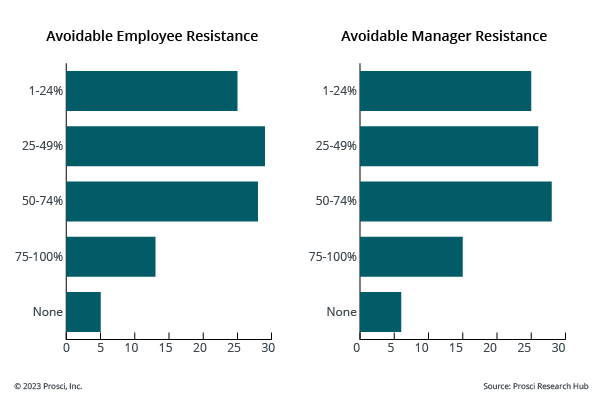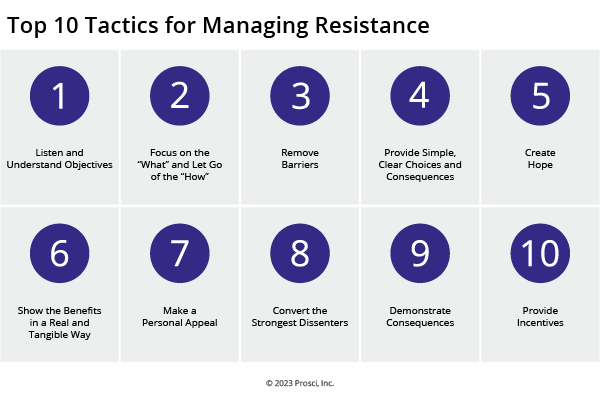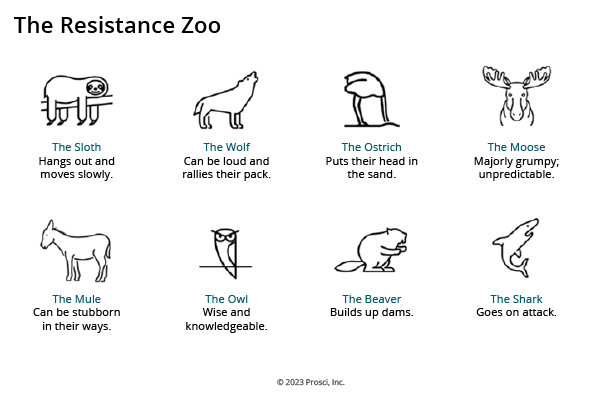It's Time to Reframe Resistance in Change Management

4 Mins
Updated: March 25, 2025
Published: May 31, 2023

Often as change managers, we think of resistance as a problem. But, instead of viewing resistance to change as a negative response to be overcome or minimized, we need to view it as an opportunity to listen, understand, and bring people along on the change journey. Shifting your mindset not only improves change outcomes but also benefits those impacted by understanding their unmet needs and fears. This is why reframing resistance is a topic worth discussing, exploring more deeply, and continuing to practice in change management.
Why Change the Way You View
Resistance Management?
Do you remember experiencing resistance on your first project? Maybe it was a front-line employee who seemed fearful, or a people manager who demonstrated behaviors that looked like stubbornness or being set in their ways. Maybe you heard rumors through the grapevine, which made you feel your project was off track or going to fail. Traditionally, we think of resistance as opposition—something we must manage, fight, push back on or dismiss. We see this in Prosci's research too. Participants often describe resistance as apathy, complaining, excuses and noncompliance. Unfortunately, the negative connotation doesn't support effective approaches for managing resistance.
We need to think differently about resistance. Instead of labeling people as resisters and dismissing them, we need to work to understand the behaviors and the fears behind them. Often, resistance is there to warn us about something that the project team might not be aware of. Understanding the unmet need driving the resistance behavior will help you reframe it—from a negative mindset of "My project is off track" to a positive mindset of "I'm grateful for the fact that people are paying attention to the project."
Resistance prevention vs. resistance response
In the Prosci Methodology, resistance prevention and resistance response are two distinct avenues for managing resistant behaviors during change:
- Resistance prevention – planning for, addressing or eliminating resistance by effectively applying change management
- Resistance response – developing effective responses when resistance becomes enduring or persistent
Resistance prevention involves identifying potential sources of resistant behaviors and proactively taking steps to minimize or eliminate them before they can become significant roadblocks. This may involve communicating the need for change, involving key stakeholders in the planning process, or providing training and support to help people adapt to new ways of working.
The most significant resistance to change emerges during the implementation of a project, which limits the amount of time you have to address it, increasing your chances of poor outcomes. Incorporating certain actions into your change management process early in the project lifecycle will help you proactively mitigate or avoid resistance:
- Deploy formal and informal surveys and assessments
- Host information sessions and training workshops
- Conduct stakeholder interviews
Managing resistance to change proactively is built into Prosci’s 3-Phase Process, which prioritizes resistance prevention in the early phases and stages of the change management process with activities such as risk assessments, ADKAR Assessments, and impact analyses. The process is designed to set up your project for success by prompting you to focus on critical areas.
Prosci 3-Phase Process

For example, if your risk assessment reveals that your ERP system implementation is a high-risk project, you need to ensure that you have strong sponsorship, strong project management, strong change management, and clear definitions of success.
The impact analysis uncovers who in the organization will be impacted by the change and how it will affect their daily work. Using the results, you can anticipate pain points and uncover resistance proactively. With our systems implementation example, the impact analysis will help you determine which groups may exhibit the most resistant behaviors. You can then uncover potential sources of those behaviors in training workshops or a "sandbox," which is a safe place for people to play with the system and test it out.
When working with clients on technology implementations and other complex projects, our Advisory Services team conducts stakeholder interviews during the discovery phase to uncover potential roadblocks early. Prosci research shows that more than half of resistance is avoidable, so taking proactive steps like this is critical for preventing and mitigating resistance.
 On the other hand, resistance response focuses on addressing resistance once it has already emerged. This approach often involves engaging with people or groups who are impacted by changes and struggling to move forward.
On the other hand, resistance response focuses on addressing resistance once it has already emerged. This approach often involves engaging with people or groups who are impacted by changes and struggling to move forward.
In resistance response, we talk with individuals or groups to understand their concerns and perspectives, and work collaboratively to find solutions that meet their needs while also moving the change initiative forward. This can be challenging and time-consuming, so resistance prevention is always the primary approach. However, you will never be able to prevent all resistance. When you can't prevent resistance or when resistant behaviors persist despite proactive measures, Prosci's Top 10 Tactics for Managing Resistance can be effective.

Resistance to Change as
Natural Behaviors
Resistant behaviors are common. It’s likely we have all seen and demonstrated some of them ourselves. When shifting your mindset about resistance behaviors during changes, it’s helpful to remember your own resistance to previous changes, why you reacted as you did, how stressful it felt, and what could have been done better to support you. This has helped me in my practice, and it can help you reframe resistance in a more positive and productive light.
The resistance zoo is a lighthearted way to regard common resistant behaviors. Certainly, resistance is not funny in terms of the impacts it can have on people and projects. But reframing resistant behaviors this way may help you identify them early, separate the behaviors from the person, and underscore the fact that resistance is a natural reaction to change.

Of the eight resistance behaviors in Prosci's research study on resistance management, I see the wolf, ostrich and owl often.
The wolf behavior can quickly escalate into a collective resistance, which we sometimes call "death by water cooler." The water cooler becomes a breeding ground for negativity as one person expresses disbelief about the change and others quickly join in, making it difficult to manage the situation.
The ostrich is one of the most common behaviors, and 75% of respondents in our research have seen it. It’s about avoidance and disengagement from the change. Ostriches bury their head in the sand and think, “If I just ignore it, maybe it'll go away.”
Encountering owl behavior can be both empathy-inducing and frustrating. Owls are often the veterans of their organizations, possessing a deep understanding of the old systems. They know the precise spot to kick that stubborn machine in the mornings, or they're credited with creating the spreadsheet workaround everyone uses. As a change practitioner, however, you're tasked with taking away that power. Even when the desire for a new system is high because it will solve major problems, people often listen to the owls and ignore the benefits of change.
Change Your Mindset
About Resistance Management
Resistance to change is challenging for everyone, and managing it poorly can lead to disastrous results. To shift your mindset, think of resistance as an opportunity to listen, understand and respond. Avoid blame or labeling people as "resisters." And instead of trying to shut down resistance, try to appreciate individuals who express resistance by responding to them with curiosity and empathy. When you reframe resistance, you anticipate and address it more effectively, and help people and projects succeed through change.



